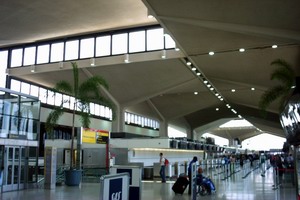August 11, 2004
Sacred Airports
 Airports are initiatory quests. The traveller approaches the airport using mundane means, from everyday life. But as he enters the complex he becomes a pilgrim seeking ascension.
Airports are initiatory quests. The traveller approaches the airport using mundane means, from everyday life. But as he enters the complex he becomes a pilgrim seeking ascension.
Just like the labyrinths in medieval churches where one follows a meandering path towards the centre, so does the pilgrims move in meandering queues towards the first initiation: check in. Their patience and endurance is tested, both by the queuing and sometimes by initiatory guides – airport personnel giving them sometimes useful, sometimes misleading information. Incantations are heard over the loudspeaker system, unintelligible to outsiders of the airport mystery cult.
As check in is achieved, the pilgrim divests himself of the symbol of his material wealth: his luggage. He trusts it to the initiates, who send it on its own journey through the underworld hopefully to emerge at the destination. The pilgrim states his true name (passport) and destination, as well as his willingness to undertake the challenges of the journey. The pilgrim – if successful - is given a boarding card, a symbolic token of his first initiation, a secret word enabling him to pass the guardians of the second initiation: the security check.
Access to the security check initiation requires the pilgrim again to state his true name and the password of the first degree. Then he moves into the higher mysteries, protected from mundane eyes by strongly worded signs forbidding photography, study or description of the security checkpoint. Now the initiate is ritually cleansed, both by again divesting himself of symbols of worldly power (shoes, bags, coats) and by being tested for uncleanness – ”insecurity”. In the initiatory system of the airport there is the world of the clean, those who have proven themselves secure through initiation or being employed as airport initiates, and the outside world of the unclean. These are kept isolated from each other like in the most rigorous Jewish or Shinto ceremonies. As the pilgrim endures his symbolic repetition of the divestment of Innanna’s regalia when visiting the underworld, he becomes one of the cleansed. Sometimes the initiates perform a ritual where a wand is passed over the body as the pilgrim makes the sign of crucifixion: again a reference to being cleansed and reborn.
Beyond the second degree initiation comes the worldly paradise. In the world of tax-free shops anything can be bought: sensual pleasures such as chocolate, food and liquor, knowledge and wisdom such as language courses and books, symbols of wealth such as electronics, jewellery and clocks as well as symbols of achievement as t-shirts and coffee mugs. The pilgrim must pass these pleasant diversions while performing the third leg on the quest, the search for the gate.
After interpreting the arcane signs and finding the gate after a long journey into the terminal fingers (the descent into the cave of the Mithraistic mysteries) the pilgrim must wait until the proper time (airport mysticism places a great important on both timeliness and patience; a bit like the Zen ideal of perfect passivity springing into perfect action at the right moment). Near the gate the pilgrim must pass the fearsome Bull of Heaven APIS and show his acceptance of the All-Knowing Powers That Be. Finally the third initiation: the encounter with the Guardian of the Gate. Here the true name, password from the first initiation, cleansing of the second initiation and sign from APIS are required to pass the test. The password boarding card is divided, and the pilgrim gets the true essence: a slip guaranteeing him a seat in the heavens.
Beyond the airport the final ordeal begins, as the now thrice initiated pilgrim prepares for his ascension. A binding seatbelt signifies his initiatory status and willingness to obey the demands imposed by the initiation (similar to bands worn in most Indo-European initiations). By placing hand luggage beneath the chair in front of him, he shows his willingness to abandon his worldly goods in the service of fellow people. By turning off all electronics he isolates himself from his past. The high priestess shows the signs and symbols of safety. Finally he has given over all aspects of his life to the high pilot initiate, a symbol of the unseen god controlling the world from the sealed cockpit.
As the pilgrim ascends into the heavens he is given symbolic gifts of reading, food and drink signifying his new status as passenger-initiate. For a time he lives a life of ascetism in a small chair, surrounded by constraints. The initiatory quest is complete, and the pilgrim moves to another world. Here the steps are reversed as the pilgrim returns to the normal world (in some cases a final initiation occurs, as the pilgrim must pass the dreaded immigration desk where his virtue is judged and the customs control where his ability to withstand temptation is judged). But as magi always say, ”every day is an initiation”. There will be at least a return-leg of the journey, corresponding to the end of the Hero’s Journey: the return to home and family with the gifts and stories of the quest.
Posted by Anders at August 11, 2004 03:17 PMgreat post, I really do kind of love airports for their spiritual quality... I think all airports should be required to pipe Eno's 'Music for Airports' or a suitable substitute soundtrack through the PA
Posted by: John Atkinson at August 16, 2004 09:41 PMI will never think of airports the same again. I especially like to land in Denver, CO with the mountains looming to the West; waiting to continue the next initiation stage. Great post.
Posted by: Leah at August 25, 2004 05:30 AM